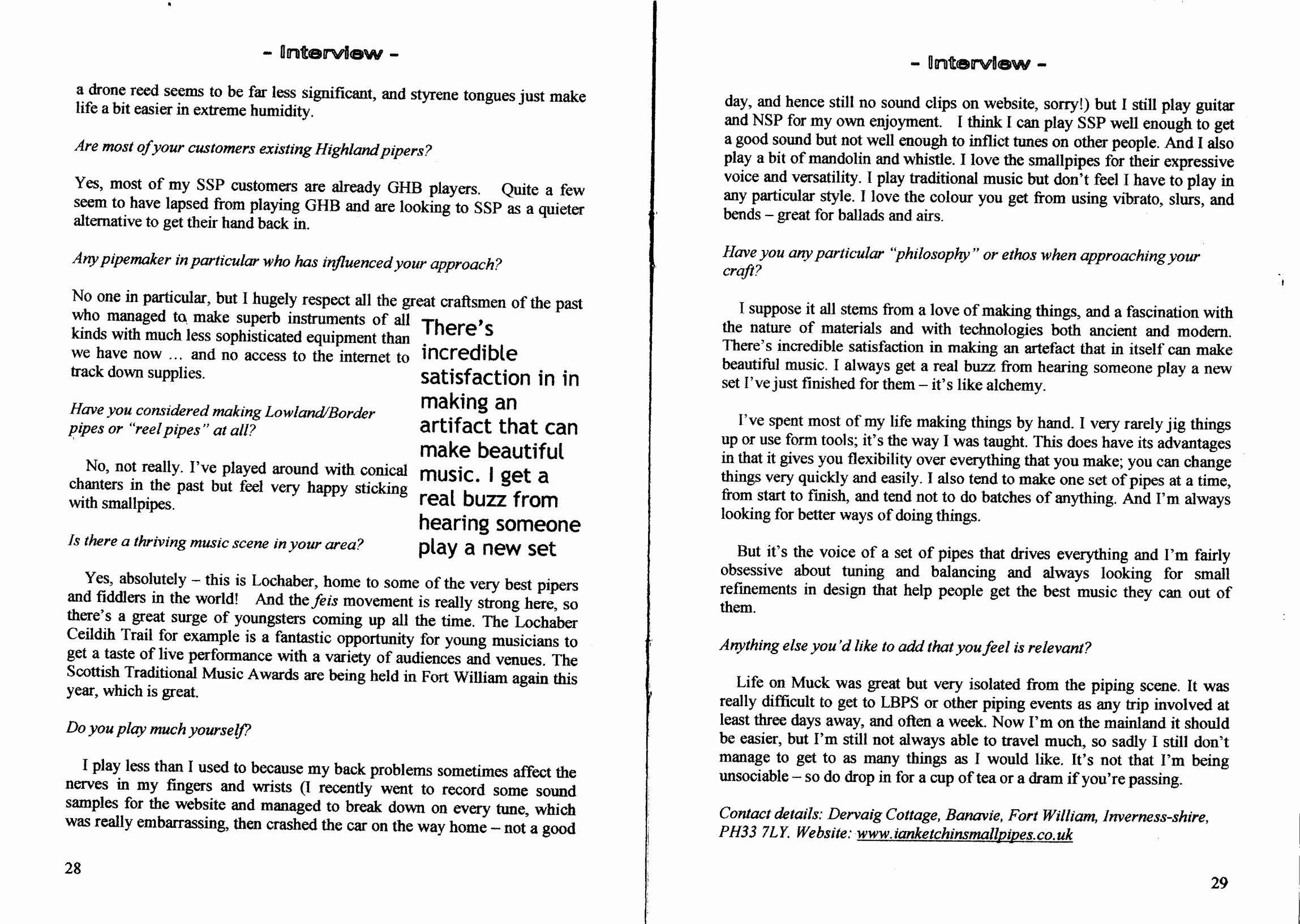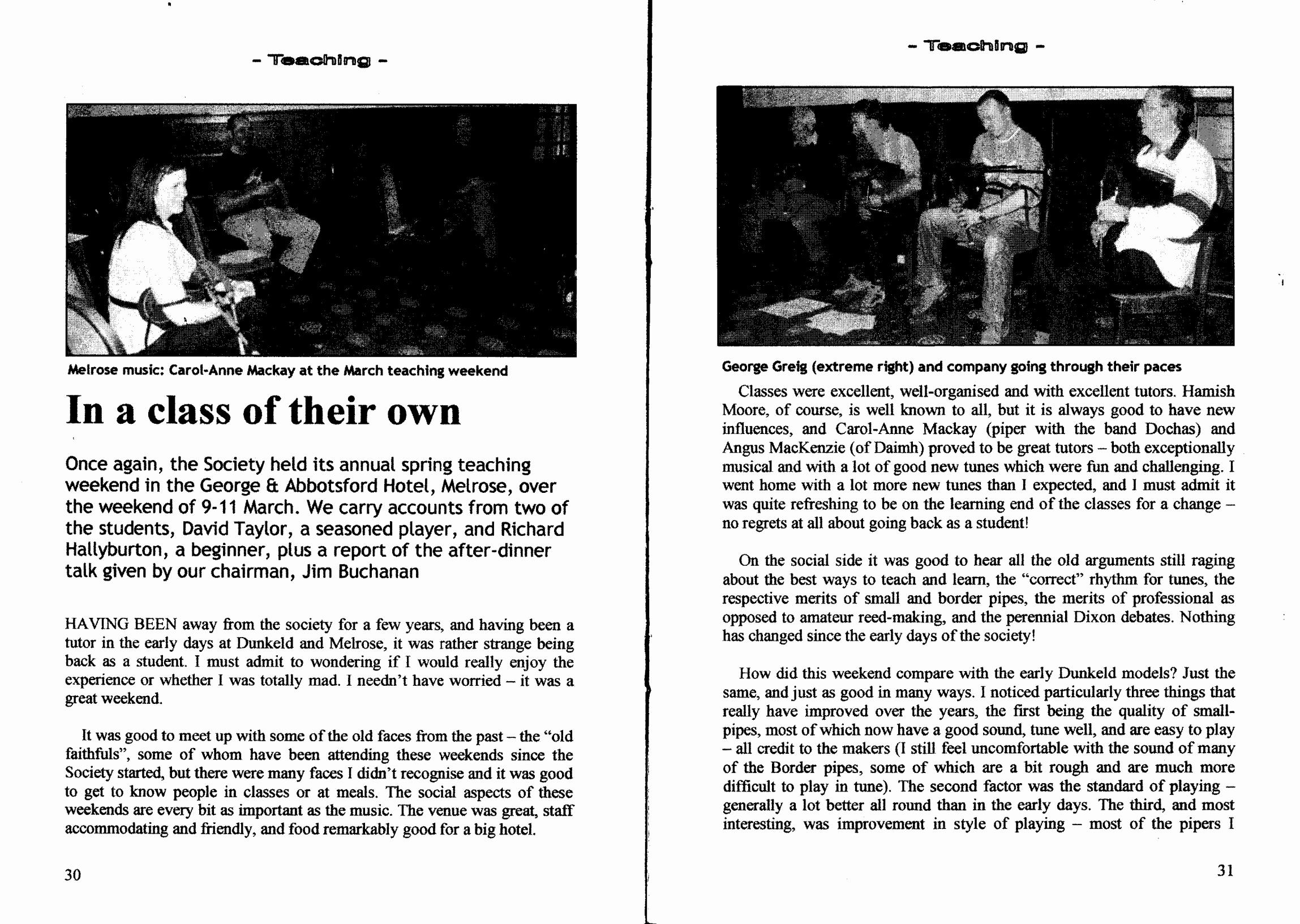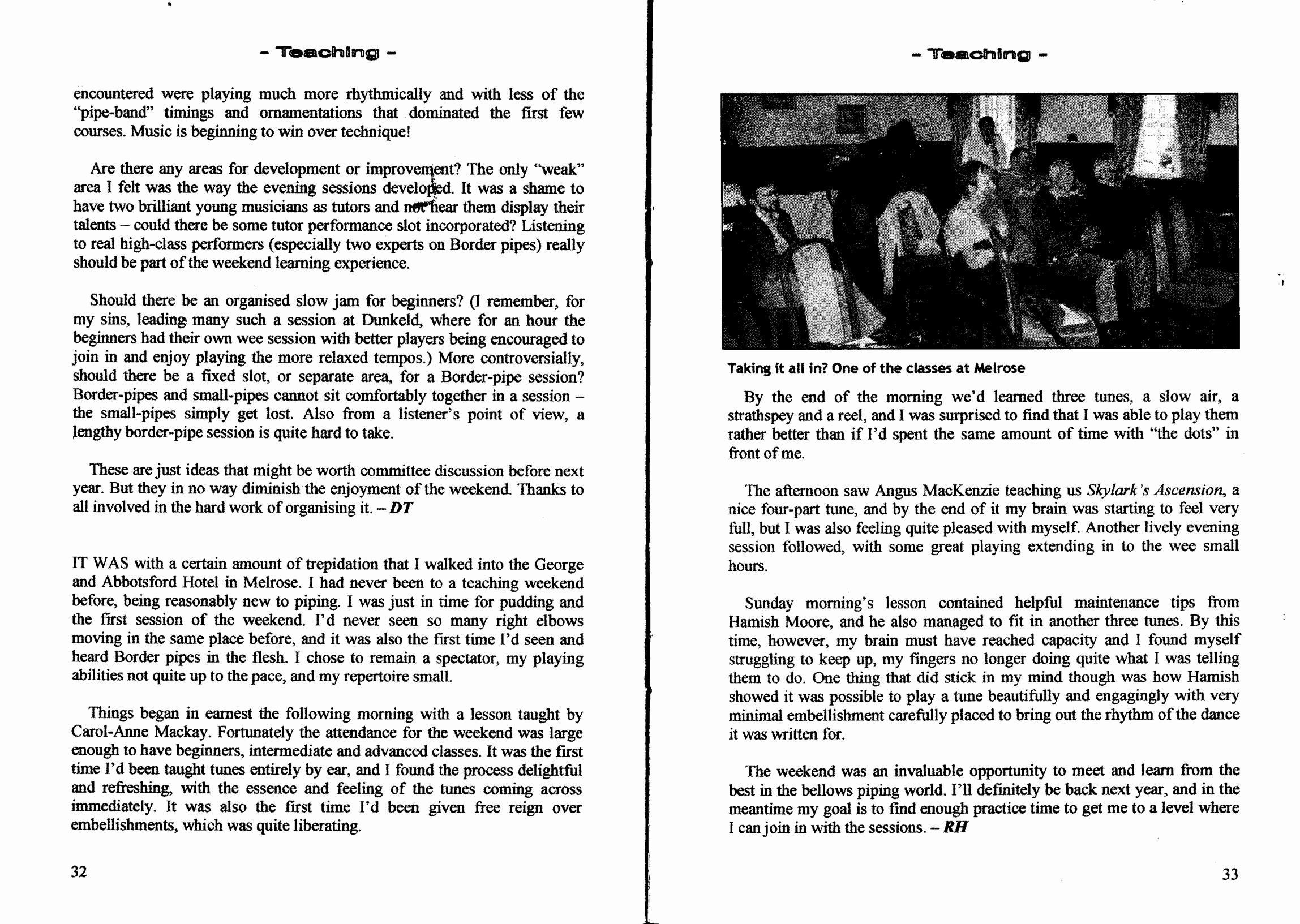LBPS Teaching Weekend, Melrose, 2007




Melrose music: Carol-Anne Mackay at the March teaching weekend
In a class of their own
Once again, the Society held its annual spring teaching weekend in the George & Abbotsford Hotel, Melrose, over the weekend of 9-11 March. We carry accounts from two of the students, David Taylor, a seasoned player, and Richard Hallyburton, a beginner, plus a report of the after-dinner talk given by our chairman, Jim Buchanan
HAVING BEEN away from the society for a few years, and having been a tutor in the early days at Dunkeld and Melrose, it was rather strange being back as a student. I must admit to wondering if I would really enjoy the experience or whether I was totally mad. I needn't have worried - it was a great weekend.
It was good to meet up with some of the old faces from the past - the “old faithfuls”, some of whom have been attending these weekends since the Society started, but there were many faces I didn't recognise and it was good to get to know people in classes or at meals. The social aspects of these weekends are every bit as important as the music. The venue was great, staff accommodating and friendly, and food remarkably good for a big hotel.
Classes were excellent, well-organised and with excellent tutors. Hamish Moore, of course, is well known to all, but it is always good to have new influences, and Carol-Anne Mackay (piper with the band Dochas) and Angus MacKenzie (of Daimh) proved to be great tutors - both exceptionally musical and with a lot of good new tunes which were fun and challenging. I went home with a lot more new tunes than I expected, and I must admit it was quite refreshing to be on the learning end of the classes for a change - no regrets at all about going back as a student!
George Greig (extreme right) and company going through their paces
On the social side it was good to hear all the old arguments still raging about the best ways to teach and learn, the “correct” rhythm for tunes, the respective merits of small and border pipes, the merits of professional as opposed to amateur reed-making, and the perennial Dixon debates. Nothing has changed since the early days of the society!
How did this weekend compare with the early Dunkeld models? Just the same, and just as good in many ways. I noticed particularly three things that really have improved over the years, the first being the quality of small-pipes, most of which now have a good sound, tune well, and are easy to play - all credit to the makers (I still feel uncomfortable with the sound of many of the Border pipes, some of which are a bit rough and are much more difficult to play in tune). The second factor was the standard of playing - generally a lot better all round than in the early days. The third, and most interesting, was improvement in style of playing
- most of the pipers I encountered were playing much more rhythmically and with less of the “pipe-band” timings and ornamentations that dominated the first few courses. Music is beginning to win over technique!
Are there any areas for development or improvement? The only “weak” area I felt was the way the evening sessions developed. It was a shame to have two brilliant young musi- cians as tutors and not hear them display their talents - could there be some tutor perfor- mance slot incorporated? Listening to real high-class performers (especially two experts on Border pipes) really should be part of the weekend learning experience.
Should there be an organised slow jam for beginners? (I remember, for my sins, leading many such a session at Dunkeld, where for an hour the beginners had their own wee session with better players being encouraged to join in and enjoy playing the more relaxed tempos.) More controversially, should there be a fixed slot, or separate area, for a Border-pipe session? Border-pipes and small-pipes cannot sit comfortably together in a session - the small-pipes simply get lost. Also from a listener's point of view, a lengthy border-pipe session is quite hard to take.
These are just ideas that might be worth committee discussion before next year. But they in no way diminish the enjoyment of the weekend. Thanks to all involved in the hard work of organising it. - DT
IT WAS with a certain amount of trepidation that I walked into the George and Abbotsford Hotel in Melrose. I had never been to a teaching weekend before, being reasonably new to piping. I was just in time for pudding and the first session of the weekend. I'd never seen so many right elbows moving in the same place before, and it was also the first time I'd seen and heard Border pipes in the flesh. I chose to remain a spectator, my playing abilities not quite up to the pace, and my repertoire small.
Things began in earnest the following morning with a lesson taught by Carol-Anne Mackay. Fortunately the attendance for the weekend was large enough to have beginners, intermediate and advanced classes. It was the first time I'd been taught tunes entirely by ear, and I found the process delightful and refreshing, with the essence and feeling of the tunes coming across immediately. It was also the first time I'd been given free reign over embel- lishments, which was quite liberating.
By the end of the morning we'd learned three tunes, a slow air, a strathspey and a reel, and I was surprised to find that I was able to play them rather better than if I'd spent the same amount of time with “the dots” in front of me.
The afternoon saw Angus MacKenzie teaching us Skylark's Ascension, a nice four-part tune, and by the end of it my brain was starting to feel very full, but I was also feeling quite pleased with myself. Another lively evening session followed, with some great playing extending in to the wee small hours.
Sunday morning's lesson contained helpful maintenance tips from Hamish Moore, and he also managed to fit in another three tunes. By this time, however, my brain must have reached capacity and I found myself struggling to keep up, my fingers no longer doing quite what I was telling them to do. One thing that did stick in my mind though was how Hamish showed it was possible to play a tune beautifully and engagingly with very minimal embel- lishment carefully placed to bring out the rhythm of the dance it was written for.
The weekend was an invaluable opportunity to meet and learn from the best in the bel- lows piping world. I'll definitely be back next year, and in the meantime my goal is to find enough practice time to get me to a level where I can join in with the sessions. - RH
Left: Taking it all in? One of the classes at Melrose
Meanwhile, chairman Jim Buchanan catered for the brandy and cigars brigade....
JIM HAD just returned from visiting his daughter and grandchildren on the island of Waiheke in the Hauraki Gulf, in New Zealand. While there, he'd been asked to give a talk to the local Rotary Club and had chosen as his subject Border piping.
As soon as he arrived in New Zealand, Jim had discovered the extent of Scots influence there: “Our taxi driver was a member of the Auckland Pipe Band and came to NZ from Hamilton, Lanarkshire when he was about six - 60 years ago. He still had a Lanarkshire accent and was passionate about piping.” Affection for the old country, however, didn't prevent Jim's proposer at the Rotary Club to come out with a string of stereotypical bagpipe jokes - eg, what's the difference between a bagpipe and a trampoline? You take off your shoes to jump on a trampoline.
Clearly a serious lecture on Border piping was going to be a non-starter, so Jim responded with a few non-bagpiping musician jokes - eg (and we're printing no more - ed), who was that piccolo I saw you with last night? That was no piccolo, that was my fife ...
Anyway, on this fine evening in New Zealand, with the comet McNaught an amazing sight, its tail trailing across a cloudless night sky, Jim finally got round to explaining to his Antipodean hosts the role of the LBPS since its formation in 1982. And in Melrose, he told the weekend gathering what he told the New Zealanders; “The Scottish small pipes and Border pipes are ‘revival' instruments and for any revival, you must have interest, enthusi- asm and, of course, the pipes themselves, but being made of wood and leather they don't last for ever. However, we do have pictures and carvings of what they looked like [not to mention surviving museum examples - ed], and thanks to the genius of pipemakers - some of whom are here in Melrose today - they have been recreated. As for interest and enthusi- asm, just look around you.”
Jim said that he explained to his Kiwi audience that “as well as reviving bellows-blown pipes and piping, members of the Society are actively researching the music and the styles of Lowland and Border piping, which it is believed did not have the complex gracings so characteristic of music played on the Great Highland bagpipe. Many players of these ‘revived' bellows-blown pipes now play music which is characterised by simple gracings used sparingly, mostly either for rhythmic emphasis or to separate repeated notes. The em- phasis is now on musicality rather than complexity such as is demanded in the world of the GHB where competitiveness rules. Many Highland pipers now use the Scottish small pipes to play Highland music in the Highland style, treating it as an indoor version of their own instrument - and there is nothing wrong with that.
“Our revival instruments have only been around for about 25 years, and are therefore still young. Ideas on playing style are still evolving. It is generally believed that the body of distinctly Borders music, probably mostly learned by ear, died out in the early to mid 19th Century. However, some survived in manuscript, notably the early Dixon MS of c. 1733, which Matt Seattle has published. Many of these must have been of Northumbrian origin, since William Dixon lived in Stamfordham, Northumberland.”
Hamish Moore (extreme right) and company in session.
This took Jim on to a more recent preoccupation in the Society, that of building bridges with fellow societies such as the Northumbrian Pipers' Society, the Bagpipe Society and the College of Piping and the Piping Centre. “We should build bridges with Irish piping socie- ties (as suggested by Hamish Moore) and this we aim to do.” He then paid tribute to our recently retired secretary: “Some of us here tonight were at Rona Macdonald's wedding.
The fact that there was an eclipse of the moon that night was purely coincidental and can have no significance in connection with the fact that Rona has chosen to retire into the shadows this year. “It was a marvellous moment at the party when the entire pipe section of the Strathclyde Fire and Emergency Service band marched in playing their Highland pipes, complete with Rona, still in full bridal attire, playing in their midst.”
“Rona (now Mrs Tony Dawson) has been such a force on the LBPS Committee over the last 14 years. She said, in a letter in the last issue of Common Stock, that it was 16 years ago that she bought her pipes from Hamish and took those fateful steps to the front door of his workshop in Birnam, and she paid tribute to the many people who have made massive personal contributions to the Society.”
Jim had further tributes to pay: “To Nigel Richard - our past chairman - and to Rona, I'd like to say that the Society owes them a major debt of thanks for all their hard work over the years.”
Jim regretted having missed much of the collogue as it had been on the same weekend that he retired from his job as secretary of the British Marine Finfish Association and had to attend a farewell dinner on the banks of Loch Fyne. Now, at Melrose, it was his great pleasure to be starting a new “career” as chairman of the Society, so, amid much applause, he proposed a toast to the Lowland and Border Pipers' Society.
